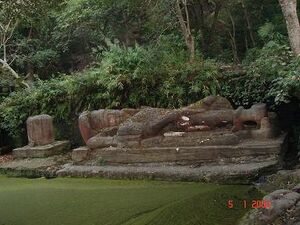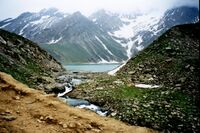Sheshanaga
Sheshanaga (शेषनाग) (110 BC-90 BC) was a Nagavanshi king, who ruled at Vidisa before the end of the Sungas.
Contents
Variants of name
- Shesha (शेष)
- Shesha naga (शेषनाग)
- Shesha Naga (शेषनाग)
Divine serpent on whom Vishnu rests
Balarama (बलराम) Balrama (बलराम), also known as Baladeva, Balabhadra and Halayudha, is the elder brother of the divine being, Krishna. Within both the Vaishnava traditions and Hinduism generally he is acknowledged as being a manifestation of Shesha, the divine serpent on whom Vishnu rests.
Jat gotras originated from Sheshanaga
- Shesano (शेसानो) gotra of Jats originated from Nagavanshi king Sheshanaga (शेषनाग).[1]
- Sheshma (शेषमा) Sheshama (शेषमा) Sheshmo (शेषमो) Sesma (सेस्मा) Seshma (सेष्मा) gotra Jats are Nagavanshi, descendant of Sheshanaga (शेषनाग). [2]
History
Ram Sarup Joon[3] writes that ....The rulers of Magadha of the Shesh Nag Dynasty were Takshak Jats. Todd writes that they ruled Mugadha for six hundred years.
Dr Naval Viyogi[4] writes....Basuki Nag, who is regarded as the presiding deit of the village, has temples in the little town of Bhadarvaha and in two villages, Bheja-uprala (ie upper Bheja, the lower village being called Bheja Jaklā) and Nālti.[5] More details of snake worship in Kashmir has already been given in chapter-I on Pages 5 and 6.
There are several towns in Kashmir having,their name after some Naga, such as Veri Nag, Anant Nag, Shesh Nag etc.
Neela[6], the lord paramount of the Nagas or serpents of Kashmir, was believed from early times, to dwell in the main source of the Vitasta (River). Hence this fine spring was known as Neela-Naga or Neela-kunda, "The deep blue colour of the water", as Sir A. Stein observes, "which collects in the spring-basin, may possibly account for the location of the Neel Naga in this particular fountain". It goes by the
[p.20] name of Ver Naga and is surrounded by a stone embankment and to its east are temples of stone. Neelanaga is still worshipped in Kashmir and fairs related to him are also held even today.[7]
In the district of Nāgām (Ancient Nāgrām) which is watered by the Dudhganga (Milkganga) a small stream which joins the Vitasta at Srinagar, there is a small lake, likewise, known by the name of Neelanaga.
Sheshnag Lake
Sheshnag Lake (शेषनाग झील) is an alpine high altitude oligotrophic lake[8]located in Anantnag district of Kashmir Valley in Jammu and Kashmir, India at an elevation of 3590 meters. It has a maximum length of 1.1 km and maximum width of 0.7 km.
Location : It is situated on the track leading to the Amarnath cave, about 23 km from Pahalgam. Sheshnag Lake is situated 120 kilometers east from Srinagar and 23 km from Pahalgam. It can be accessed[9] 113 km by road up to Chandanwari from which ponies can be hired to cover a trek of 7 km upslope to reach the Sheshnag Lake. Amarnath Temple is situated 20 kilometers north of this lake.
शेषनाग झील
पहलगाम से 23 किलोमीटर की दूरी पर स्थित शेषनाग झील नागवंशी राजा शेषनाग के नामपर है। यह झील अमरनाथ यात्रा के रस्ते में पड़ती है। शेषनाग झील जम्मू और कश्मीर में अमरनाथ गुफ़ा के पास स्थित एक धार्मिक झील है। यह पर्वतमालाओं के बीच नीले पानी की एक ख़ूबसूरत झील है। अमरनाथ हिन्दुओं का एक प्रमुख तीर्थस्थल है। यहाँ की प्रमुख विशेषता पवित्र गुफा में बर्फ़ से प्राकृतिक शिवलिंग का निर्मित होना है। प्राकृतिक हिम से निर्मित होने के कारण इस स्वयंभू हिमानी शिवलिंग भी कहते हैं। यह झील क़रीब डेढ़ किलोमीटर लम्बाई में फैली है। यह झील चन्दनवाडी से लगभग 16 किमी और पहलगाम से लगभग 23 किमी की दूर पर है।
Nagas of Vidisa
- This content is from Chapter-12 of Dr Naval Viyogi's Book - "Nagas: the Ancient Rulers of India, p.330-332
[p.330]: The Nagas were serpent worshipping non-Aryaan civilized race of ancient India. Many localities and cities were named after them e.g. Nagpur, Nagardhan (Nagar-Vardhan), Nagar, Karkotnagar Nagarkhonda, Nagarkot, Nagarkoil etc. They flourished in North, East, Central and South India in ancient time. The evidences from the Puranas and other sources show that the Naga kings ruled at Takshila, Tankshar, Singhpur, Tonk, Mathura,Karkotanagar, Mathura, Indaurpura, Padmavati, Kantipuri, Vidisa, Purika, Nagpura, Nandi-Vardhan, Eran, Paithan, etc. In Mahabharata period these Nagas were ruling in North West with their capital at Takshila and at Patalpuri around present Karachi and Hyderabad. From there they drifted to south and east i.e. from the Panjab to Rajasthan and Madhya Pradesh in a time which cannot be ascertained now. The Puranas l divide the Naga dynasty of Vidisa into two parts:
The first part belonged those kings who flourished before the end of the Sungas with their capital at Vidisa (31 B.C.). The Kings before this period in the Naga dynasty were Sesha, Bhogin, Ramchandra, Nakhvan, Dhanavarman or Dharma Varnan and Vangara.
At this period the Andhra Kings 2 had taken Susarman (The, last Kanva King) a prisoner and destroyed whatever had been left of the Sunga power at at time (at Vidisa). This statement of Puranas refer to the Andhra or Satavahana period, when they became emperors of Aryavarta in addition to their being the emperors of Dakshinapath at about 31 B.C. 3 It means, perhaps due to pressure from Satavahanas they shifted their capital to Padmavati.
Before proceeding further let us see how the Vayu Purana has called these Vidisa Nagas, Vrisha or Siva's bull i.e. Nandi, with which, the names of the kings coming after the close of the Sunga dynasty, end. It seems that the title Bharsiva which was taken up later is connected conceptually with the Vrisha of the Vayu and the Nandi. 4 It means these Nagas were ethnically5 related to Bharsivas or Nav Nagas (Taka a family
1.Mahajan V.D., "Ancient India" P-377.
2.Jayaswal KP. "History of India" P-9.
3.JBORS I P-1l6.
4.Jayaswal KP. P-lO.
5.Jayaswal K.P. P-18.
[p.331]: of Panjab see Chapter VI P-144 of later priod. We know Indus Valley people were also worshipers of God Siva. 6
The second part of these Nagas belonged to those kings who flourished after the end of the Sungas. The names of these post Sunga Nagas were Bhuta Nandi or Bhutinandi, Sisunandi and Yasonandi. It appears that from the time of Bhutanandi, when the dynasty was reestablished, they made Padmavati their capital. There is a positive confirmation of the existence of these post Sunga Nagas in the first century A.D. At Padmpawaya, which is the site of Padmavati, a statue of Yaksha Manibhadra was dedicated by some members of a public body in the fourth year of the reign of "King Svami Sivanandi"7. Similarly a famous Sivalingam called Swarn-Vindu was also established there. The plat form of the Swarn-Vindu Siva has been discovered by Mr. Garde at Pavaya. 8 An image of Nandi, with human body and Bull's head has been found there .
Let us take series of coins which according to Jayaswaal9 belongs to
this early Naga dynasty. Some of the Coins are generally assigned to Mathura. In the British Museum there are coins of Seshadata, Ramdata and Sisuchandra-data. The script of the Seshadata's coin is the oldest and belongs to the first century B.C. In the same series, there are coins of Ramadata. These coins, according to the opinion of Jayaswal, are identical with Sesha-Naga, Ram-chandra and Sisu Nandi of this dynasty.
As the Puranas generally omit the names when a dynast comes under an over Lordship, Shiva nandi was probably the king superseded by Kanishka. It is stated in the Puranas that Padmavati passe under a ruler named Vinvasphani, who is to be identified with the viceroy of Kanishka, Mahakshatrapa Vanaspara.11 It proves that during the period 80-175 AD comes the Kushana rule with the withdrawal of the Naga Kings to Purika and Nagpur-Nandi-Vardhana in the central provinces. 12
Pedigree and chronology of the Nagas of Vidisa
After a lot of discussion K.P. Jayaswal gave the following pedigree and chronology of the Nagas of Vidisa :
| S.No | Naga King | Period | Comment |
|---|---|---|---|
| (1) | Sesha Naga | 110-90 BC | Kings (S.No. 1-5) ruled at Vidisa before the end of the Sungas |
| (2) | Bhogin | 90-80 BC | |
| (3) | Ramachandra | 80-50 BC | |
| (4) | Dharma Varman | 50-40 BC | |
| (5) | Vangara | 40-31 BC | |
| At this time Satavahanas destroyed Sunga Kanvas. | |||
| (6) | Bhuta Nandi | 20-10 BC | Kings (S.No. 6-8) ruled at Padmavati after the end of Sungas |
| (7) | Sisu Nandi | 10 BC-25 AD | |
| (8) | Yash Nandi | 25-~0 AD | |
| (9) | Purusha data | These five kings (S.No. 9-13) are known from the inscriptions & coins and their order of succession is also uncertain. | |
| (10) | Uttam data | ||
| (11) | Kama data | ||
| (12) | Bhava data | ||
| (13) | Siva Nandi or Sivadata | 78 AD. | superseded by Kushanas |
Foot notes -
6.Rao S.R., "Lothal and the Indus civilization" P-190.
7.ASR 1915-16 P-106 Plate LXI.
8.ASR 1915-16 PP-lOO FF.
9.Jayaswal KP. P-12.
10.ASR Vol XII P-43.
11.Jayaswal KP. poll.
12.Jayaswal K.P. P-14.
[p.332]: Jayaswal has pointed out that last five kings are known only from inscriptions and coins. Their order of succession is also uncertain. All the 13 Naga Kings covered a period of about 200 years from 110 BC to 78 AD. 13
13. Jayaswal K.P.-15.
References
- ↑ Dr Mahendra Singh Arya etc,: Ādhunik Jat Itihas, Agra 1998, p. 281
- ↑ Dr Mahendra Singh Arya etc, : Ādhunik Jat Itihas, Agra 1998, p. 281
- ↑ History of the Jats/Chapter II,p.31
- ↑ Nagas, The Ancient Rulers of India, Their Origins and History, 2002, pp. 19-20
- ↑ Vogel J. PH. P-250
- ↑ Vogel J PH. P-227
- ↑ Vogel J. PH. "Ibid" P-228
- ↑ Raina, HS; KK Vass (May–June 2006). "Some biological features of a freshwater fairy shrimp, Branchinecta schantzi, Mackin, 1952 in the Northwestern Himalayas, India" (PDF). J. Indian Inst. Sci. 86: 287–291.
- ↑ "Pahalgam Sheshnag". cambaytours.com.
Back to The Ancient Jats

